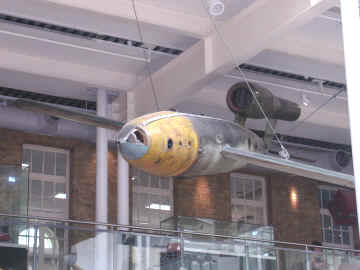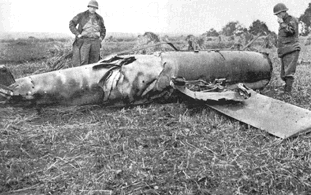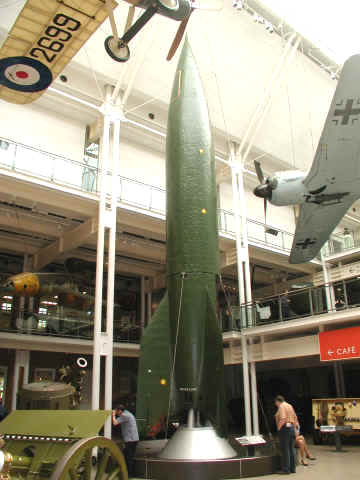The V weapons – the V1 and V2 – were used towards the end of World War Two with such an effect that the attacks on London became known as the second Blitz. The success of D-Day had speeded up the production of the V weapons and the first V1 was launched on June 13th, just one week after the Allied landings at Normandy.
|
A V1 at the Imperial War Museum, London |
The V weapons were built at Pennemunde, a remote island off the Baltic. Here, the Nazis had assembled a group of scientists and a workforce who worked under the greatest of secrecy. In 1943, the Polish underground movement had sent back information about the base and the RAF had aerial photographs of the site. In August 1943, a heavy bombing raid by the RAF caused serious damage to Pennemunde and pushed development back some months but the project was not halted altogether.
The V1 and V2 were to be weapons of revenge – the Vergeltungswaffens. These were the fabled secret weapons that Hitler boasted about; the weapons that would win the war for Nazi Germany.
|
A damaged V1 found by the Allies |
By February 1944, 96 launch sites had been built for the V1. The R.A.F and the U.S.A.F. destroyed 73 but the remaining 23 were to cause many problems for Southern England.
The V1 carried one ton of high explosives and travelled at a maximum of 400 mph. It had a maximum flying distance of 200 miles but the weather could decrease this. A pre-set magnetic compass and gyroscopic auto-pilot determined and maintained its course. A small propeller at the front of the weapon registered the distance covered. At a pre-set distance, the guidance system cut the power to the engine and the V1 went into a steep dive.
Between 8,000 and 9,000 V1’s were launched against Southern England, primarily London. After the initial shock of the first ones, their impact was limited as V1’s could be shot out of the sky by anti-aircraft fire as these guns could lock onto the trajectory of the incoming V1. The Royal Observer Corps gave an early warning of incoming V1’s. Fighter planes were also used to tip over the ‘wings’ of the V1 so that it continued to fly but off course. Over 50% of the V1’s fired at Britain were destroyed before they crashed to the ground and exploded.
Far more dangerous was the world’s first rocket – the V2. This was developed by Wernher von Braun and his team at Peneemunde. This rocket carried one ton of high explosive but travelled at such a speed that it could not be seen. Its terminal speed was 2,386 mph.
|
|
Whereas the V1 was a visible weapon, the V2 was invisible. These weapons spread considerable fear in London. In response to them the government used its intelligence units to convince the Nazis that the government had moved its base from central London to the Dulwich area of London. This worked and the V2’s were targeted towards Dulwich. About 1000 V2’s were fired at Britain before their launch sites were overrun by the advancing Allies. In total they killed or wounded about 115,000 people.
It is difficult to assess the true military value of the V weapons. Their psychological impact was probably greater than the actual damage they did. With the V2’s no one knew in London whether they would be the next victim. But they were not used against the advancing Allied armies or against the Russians. Antwerp, a vital port for the Allies, was devastated by attacks from V weapons but, in general, they were used on civilian targets only.
Albert Speer in his book “Inside the Third Reich” claims that the V weapons (especially the V2) could have been working many months before June 1944 if the men at Peneemunde had been given more support from Berlin. Speer cited Goering as the man who had little faith in the project. Their impact, if used from an earlier date, might have been greater.


